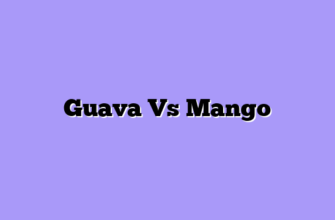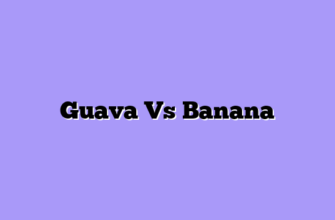Pink guava and white guava are two popular varieties of guava, each with its own unique flavor and characteristics. Pink guava is known for its sweet and slightly tart flavor, while white guava is known for its milder, sweeter taste. Both varieties are rich in vitamins and antioxidants, making them a healthy and delicious fruit option.
Taste and Flavor Profile
Pink guavas, known for their vibrant pink flesh, boast a more intense and complex flavor. Their sweetness is often described as being more pronounced, with a hint of floral notes that add a touch of elegance. This sweetness is balanced by a tangy acidity, creating a harmonious blend that is both refreshing and satisfying. The pink guava’s flavor profile is further enhanced by a subtle hint of spice, adding a layer of depth and complexity. This spice note is often attributed to the presence of lycopene, a powerful antioxidant that gives the fruit its vibrant color.
White guavas, on the other hand, offer a milder and more delicate flavor. Their flesh, as the name suggests, is white or pale yellow, and their sweetness is less pronounced than that of their pink counterparts. The tartness is also more subdued, resulting in a smoother and less acidic taste. White guavas are often described as having a slightly creamy texture, which adds to their overall pleasantness. This mildness makes them a versatile fruit, suitable for a wide range of culinary applications, from fresh eating to jams and jellies.
The difference in flavor between pink and white guavas can be attributed to several factors, including the variety, growing conditions, and ripeness. Pink guavas, for instance, are often grown in warmer climates, which may contribute to their more intense flavor. Additionally, the ripeness of the fruit plays a significant role in its flavor profile. Ripe pink guavas are sweeter and more flavorful than unripe ones, while ripe white guavas retain their mildness.
Nutritional Content and Health Benefits
Pink guava, as its name suggests, boasts a vibrant pink flesh, often with a deeper red hue towards the center. This vibrant color is attributed to lycopene, a powerful antioxidant known for its role in protecting against certain cancers and heart disease. White guava, on the other hand, features a pale white or cream-colored flesh, lacking the lycopene content found in its pink counterpart.
In terms of nutritional content, both pink and white guava are excellent sources of vitamin C, a potent antioxidant that supports immune function and collagen production. However, pink guava generally contains higher levels of vitamin C, contributing to its reputation as a potent source of this essential nutrient. Additionally, pink guava is richer in potassium, a mineral crucial for maintaining healthy blood pressure and muscle function.

The higher lycopene content in pink guava has been linked to several potential health benefits. Studies suggest that lycopene may help reduce the risk of certain cancers, including prostate and breast cancer. It may also contribute to heart health by lowering cholesterol levels and protecting against oxidative stress.
While white guava lacks the lycopene found in pink guava, it still offers a range of health benefits. Its high fiber content can aid in weight management and improve blood sugar control. The vitamin C and potassium in white guava contribute to overall health and well-being.
Ultimately, the choice between pink guava and white guava depends on individual preferences and dietary needs. Pink guava, with its higher lycopene content, may be a better choice for those seeking additional antioxidant benefits. White guava, with its milder flavor and slightly lower calorie count, may be preferred by those seeking a more subtle taste or a lower-calorie option.
Growing and Harvesting
Pink guava, known for its vibrant pink flesh, tends to mature earlier than its white counterpart. This earlier ripening period necessitates a more vigilant approach to harvesting. Farmers must carefully monitor the fruit’s development, ensuring that it reaches optimal ripeness without becoming overripe. Overripe pink guava can develop a mealy texture and lose its characteristic sweetness. In contrast, white guava, with its pale flesh, typically ripens later, allowing for a slightly more relaxed harvesting schedule. However, this does not imply a lack of attention. White guava, while more resilient to overripening, can still succumb to spoilage if left on the tree for too long.
The growth habits of these two varieties also differ. Pink guava trees tend to be more compact and bushy, making them suitable for smaller gardens or urban settings. Their compact nature also facilitates harvesting, as the fruit is more readily accessible. White guava trees, on the other hand, are known for their sprawling growth habit, often reaching considerable heights. This characteristic necessitates the use of ladders or other harvesting aids, particularly when the fruit is located in the upper branches.
The harvesting process itself also varies slightly between the two varieties. Pink guava, due to its earlier ripening, is often harvested by hand, allowing for a more selective approach. This method ensures that only the ripest fruit is picked, maximizing quality and minimizing waste. White guava, with its later ripening, can be harvested using a combination of hand-picking and mechanical methods. Mechanical harvesting, while efficient, can sometimes damage the fruit, leading to a lower quality yield.
Despite these differences, both pink and white guava require similar environmental conditions for optimal growth. Both varieties thrive in warm, humid climates with ample sunlight. They also prefer well-drained soil with a slightly acidic pH. Proper irrigation is crucial, especially during the dry season, to ensure consistent fruit production.
Culinary Uses and Recipes
Pink guava, with its vibrant pink flesh and slightly tart flavor, is often favored for its versatility. Its higher acidity makes it an excellent choice for jams, jellies, and chutneys, where its tartness balances the sweetness and creates a complex flavor profile. The firm texture of pink guava also makes it ideal for salsas and chutneys, as it holds its shape well when chopped. Additionally, its vibrant color adds a visually appealing element to dishes.
White guava, on the other hand, boasts a milder, sweeter flavor and a softer, more delicate texture. Its sweetness makes it a popular choice for desserts, such as pies, cakes, and ice cream. The soft texture of white guava allows it to be easily pureed, making it perfect for smoothies, juices, and even sauces. Its delicate flavor also complements savory dishes, such as grilled chicken or fish, adding a touch of sweetness and tropical flair.
When it comes to recipes, both pink and white guava offer a wealth of possibilities. For a refreshing summer drink, try blending white guava with yogurt, honey, and ice for a creamy and flavorful smoothie. Alternatively, pink guava can be used to create a tangy and vibrant salsa, combining it with chopped onions, cilantro, lime juice, and a touch of chili powder.
For a sweet treat, consider baking a white guava pie, using the fruit’s natural sweetness to create a delicious and comforting dessert. Alternatively, pink guava can be used to make a vibrant and tangy jam, simmering the fruit with sugar and lemon juice until it reaches a thick and spreadable consistency.
Beyond traditional uses, both pink and white guava can be incorporated into modern culinary creations. Pink guava’s tartness can be used to balance the richness of a creamy cheesecake, while white guava’s sweetness can be used to enhance the flavor of a savory chicken salad.
Cultural Significance and History
The pink guava, with its vibrant hue and sweet, aromatic flesh, has long been celebrated for its versatility. In many cultures, it is considered a symbol of abundance and prosperity, often featured in festive gatherings and religious ceremonies. Its vibrant color is associated with joy, vitality, and good fortune, making it a popular choice for decorations and offerings. In the Caribbean, for instance, pink guava is a staple ingredient in jams, jellies, and chutneys, its sweet flavor complementing the region’s spicy cuisine. Its juice, rich in antioxidants and vitamins, is often consumed as a refreshing beverage, particularly during hot summer months.
The white guava, on the other hand, holds a different cultural significance, often associated with purity, simplicity, and tranquility. Its delicate flavor, less sweet than its pink counterpart, is often appreciated for its subtle sweetness and refreshing qualities. In some regions, white guava is considered a symbol of peace and harmony, its pale color representing serenity and calmness. In Southeast Asia, for example, white guava is frequently used in traditional medicine, its leaves and bark believed to possess soothing and anti-inflammatory properties. Its mild flavor also makes it a popular ingredient in desserts and salads, adding a touch of freshness and elegance.

The cultural significance and historical evolution of pink and white guava highlight the intricate relationship between humans and nature. These two varieties, seemingly simple fruits, have played a profound role in shaping culinary traditions, medicinal practices, and social interactions across diverse cultures. Their distinct characteristics, from color and flavor to cultural symbolism, reflect the rich tapestry of human experience, reminding us of the interconnectedness of our world.
Q&A
**1. What is the main difference between pink and white guavas?**
**Answer:** The main difference is the color of their flesh. Pink guavas have a pink or reddish flesh, while white guavas have a white or pale yellow flesh.
**2. Which guava has a sweeter taste?**
**Answer:** Pink guavas are generally considered sweeter than white guavas.
**3. Which guava is more aromatic?**
**Answer:** White guavas are known for their stronger, more intense aroma compared to pink guavas.
**4. Which guava is better for juicing?**
**Answer:** Both pink and white guavas can be used for juicing, but pink guavas are often preferred due to their sweeter taste.
**5. Which guava is more common?**
**Answer:** White guavas are more commonly found in markets and are generally more widely available.








